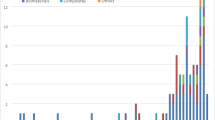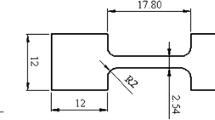Abstract
A modified version of the Kolsky thin-wafer technique is described. The method permits one to obtain the dynamic plastic properties of materials at strain rates as high as 105 sec−1. Data obtained from compression tests on high-purity aluminum are presented for strain rates ranging from 4000 to 120,000 sec−1 at room temperature. Specimen-size effects and the effect of lateral inertia are taken into account in analyzing the data.
The results plotted as stress vs. strain rate at constant strains (5 to 20 percent) show that, at the highest strain rates, the stress rises very rapidly with strain rate suggesting that a limiting strain rate is being reached. At the lower strain rates (103 to 104 sec−1), the stress is linearly proportional to the strain rate indicating that the material is deforming in a viscous manner.
Similar content being viewed by others
References
Kolsky, H., Proc. Roy. Phys. Soc.,B 62,676–700 (1949).
Larsen, T. L., Rajnak, S. L., Hauser, F. E. andDorn, J. E., J. Mech. Phys. Solids,12,361 (1964).
Hauser, F. E., Simmons, J. A. andDorn, J. E., Response of Metals to High Velocity Deformation, Interscience, New York,93 (1961).
Dorn, J. E., Mitchell, J. andHauser, F. E., “Dislocation Dynamics,”Experimental Mechanics,5 (11),353 (1965).
Ferguson, W. G., Kumar, A. andDorn, J. E., J. Appl. Phys.,38,1863 (1967).
Ferguson, W. G., Hauser, F. E. andDorn, J. E., Brit. J. Appl. Phys.,18,411 (1967).
Hauser, F. E., “Techniques for Measuring Stress-Strain Relations at High Strain Rates,”Experimental Mechanics,6 (8),395 (1966).
Seeger, A., Dislocations and Mechanical Properties of Crystals, John Wiley, New York, 243 (1956).
Klepaczko, J. and Hauser, F. E., (to be published).
Stein, P. K., Strain Gage Readings,6,3 (1963).
Hauser, F. E. and Winter, C. A., University of California Materials Research Laboratory Publication, Series 133, No. 4 (1960).
Lindholm, U. S., J. Mech. Phys. Solids,12,317 (1964).
Author information
Authors and Affiliations
Additional information
This paper is based on a part of the PhD thesis, Department of Mechanical Engineering, University of California, Berkeley, Calif.
Rights and permissions
About this article
Cite this article
Dharan, C.K.H., Hauser, F.E. Determination of stress-strain characteristics at very high strain rates. Experimental Mechanics 10, 370–376 (1970). https://doi.org/10.1007/BF02320419
Issue Date:
DOI: https://doi.org/10.1007/BF02320419




